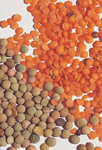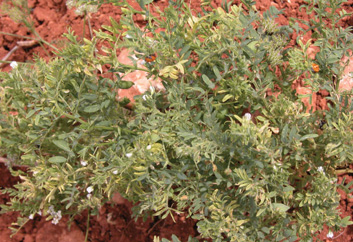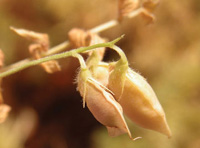

The two main types of lentils in the Middle East: large, dark lentils and smaller, red lentils.
DUPED BY SOUP? JACOB, HAVING taken advantage of his brother through deceit, prepared a lentil soup: “Esau said to Jacob, ‘Give me a mouthful of that red stuff there [lentil stew], I am exhausted’” (Genesis 25:30, 34, NJB).
In the Quran, the sole mention of lentils is in the “vegetable list” of Egyptian foods missed by the Children of Israel: “Remember, when you said: ‘O Moses, we are tired of eating the same food (day after day), ask your Lord to give us fruits of the earth, herbs and cucumbers, grains and lentils and onions’” (Sura 2:61, Ali). In the same incident recorded in the Bible in Numbers 11:5, lentils are not mentioned.
Lentils, as in Bible days, are a significant food crop in the modern Middle East. Despite their widespread planting and use in a variety of dishes, the inclusion of this legume crop in the holy books is disproportionate to their importance and use. Lentils were among the most important crops in ancient Egypt (Murray 2000).
In addition to their inclusion in the story of Jacob and in the incident in the Quran, lentils are mentioned in II Samuel 17:28; II Samuel 23:11; and Ezekiel 4:9. Lens culinaris, lentils, were widely planted and utilized during Bible times. Like many other legumes, lentils are rich in essential amino acids, so they are a good supplement to a low-protein diet.
Lentil plants are low-growing, delicate annuals with small, white or bluish flowers. They are planted in the winter and are harvested in late spring or early summer, a cropping system that is the same as for barley and wheat. An interesting thing about the culture of lentils is that they are often grown in small patches. It is not uncommon to see a patch of lentils only a few meters (6 feet or more) in diameter among olive trees or on a ledge in the mountains.

Lentils grown in test plots at the International Center for Agricultural Research in the Dry Areas (ICARDA) near Aleppo, Syria. ICARDA is a world center for the study of lentils.

Fruits (legumes) of lentil. Each legume contains only a few seeds.
Harvested lentil and barley are often taken to the same threshing floors because they ripen at the same time. These threshing floors in the region appear little changed since Bible days, with large flat rocks as a stone platform, worn smooth by centuries of threshing and surrounded by stone walls.
There are two main types of lentils in the Middle East. One is a large, dark lentil; this type is boiled and eaten without the seed coat removed. A common village food in the Middle East is a mixture of bulgur (burghul in Arabic) and lentils. The second is a small lentil with red cotyledons and a thick seed coat, which is usually prepared by grinding off the outer layer, the seed coat, leaving the red cotyledons. Lentils of this type cook more rapidly and are usually made into soups. The seed coat residue is fed to animals.
Widely grown, nutritious, and ancient, lentils are important throughout the Middle East. Little wonder that they are mentioned in both holy books.